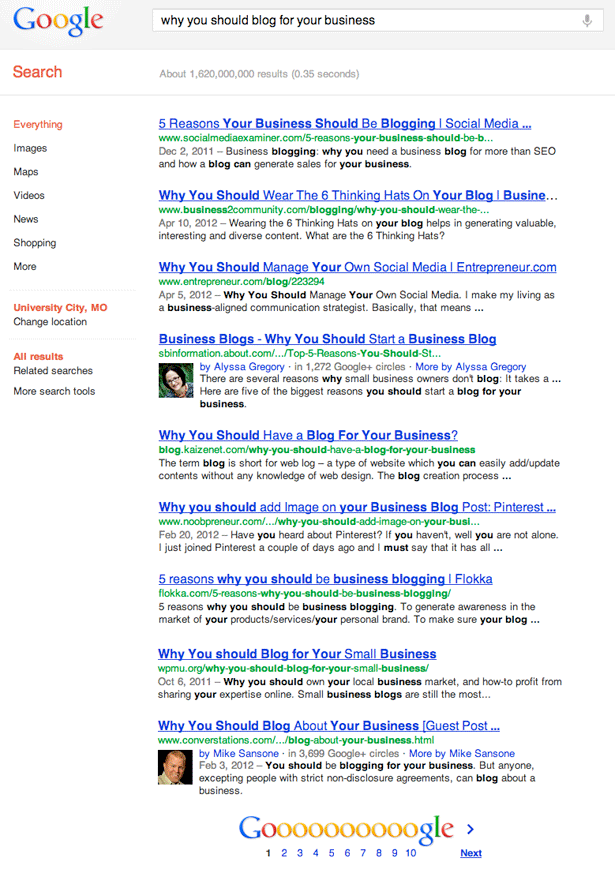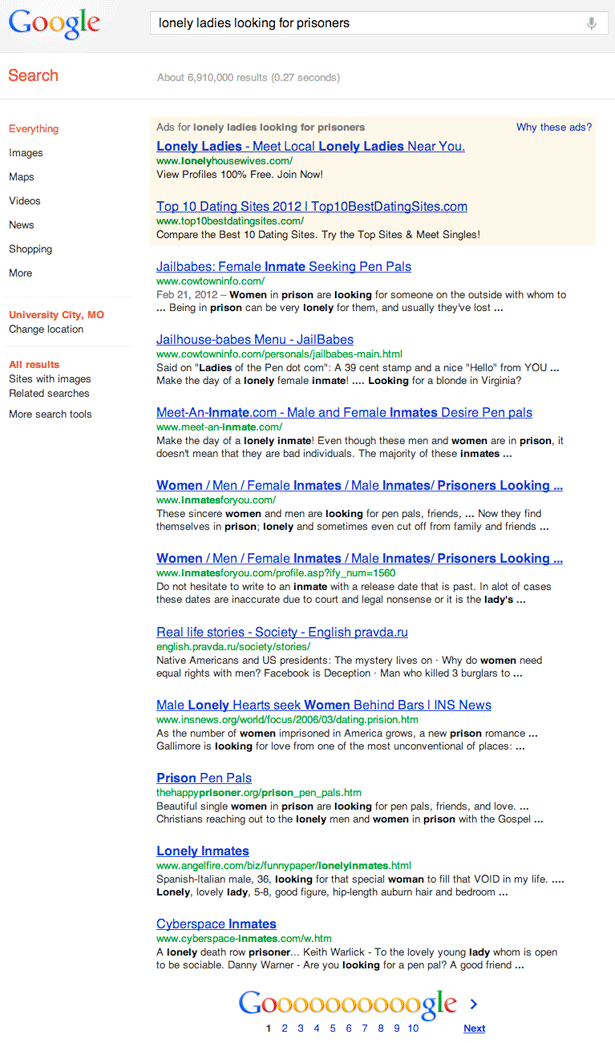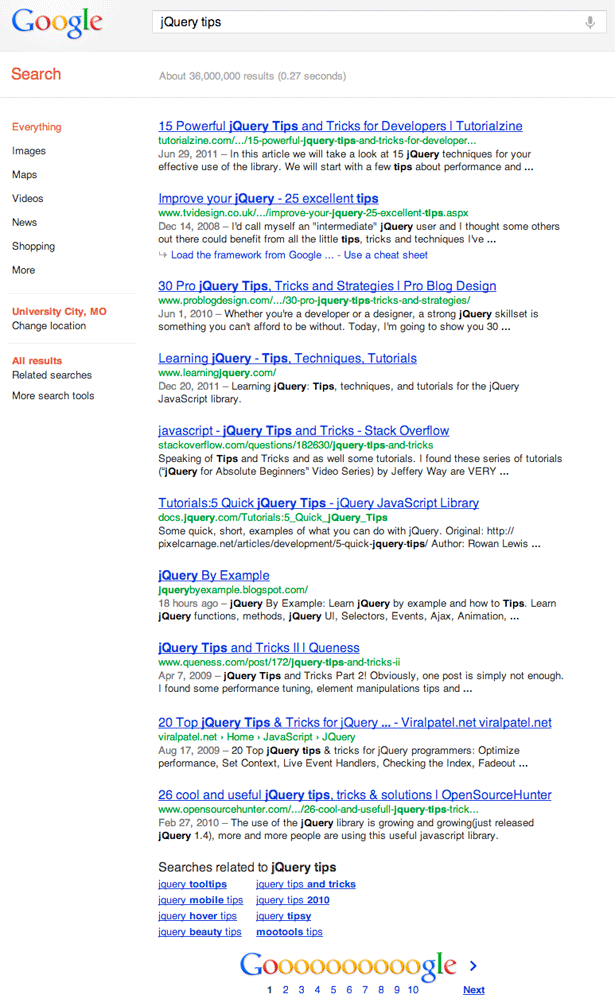 Obviously you are reading this blog. Why? You learn something that helps you become a better designer is the popular answer. Blogs inform, educate and entertain. Then there's The Oatmeal, which is just weird but people love it.
Webdesigner Depot is just one of the top design blogs and, as I tell the editors for the blogs for which I write, “get this article published quickly before it’s covered in another blog!”
Sometimes I submit an article just as the same subject is published elsewhere. Usually, I just write something so different, there’s no chance anyone else will cover the same subject.
That’s why I have a growing, albeit sick, following. You can have the same following, too!
After an article of mine is published, I check out the Google returns to see how many other blogs have reposted the article. One recent article had 74.1 million returns.
“WOW!” I thought. “Everyone in the world loves me!”
Truthfully, Google returns have an odd algorithm and it wasn’t 74.1 million unique reposts. Let’s assume that every repost was listed three times, which still may be very generous to my ego. That would mean…doing the math…carry the one…the rabbit runs around the tree and THEN goes in the hole…three is a magic number…conjunction junction, what’s your function…and the answer is eleventeen million, er, 24.7 million. Still, that’s great for my ego but bad news for blogs that rely on reaching unique hits from readers.
Are there really over 24 million blogs dedicated to design in the world? I’ve seen the horror while I click through page after page on Google, viewing the names of design blogs that don’t need translation into English. That’s a lot of competition for the attention of a segment of the population that doesn’t have a lot of time to read between releases of Harry Potter books.
Obviously you are reading this blog. Why? You learn something that helps you become a better designer is the popular answer. Blogs inform, educate and entertain. Then there's The Oatmeal, which is just weird but people love it.
Webdesigner Depot is just one of the top design blogs and, as I tell the editors for the blogs for which I write, “get this article published quickly before it’s covered in another blog!”
Sometimes I submit an article just as the same subject is published elsewhere. Usually, I just write something so different, there’s no chance anyone else will cover the same subject.
That’s why I have a growing, albeit sick, following. You can have the same following, too!
After an article of mine is published, I check out the Google returns to see how many other blogs have reposted the article. One recent article had 74.1 million returns.
“WOW!” I thought. “Everyone in the world loves me!”
Truthfully, Google returns have an odd algorithm and it wasn’t 74.1 million unique reposts. Let’s assume that every repost was listed three times, which still may be very generous to my ego. That would mean…doing the math…carry the one…the rabbit runs around the tree and THEN goes in the hole…three is a magic number…conjunction junction, what’s your function…and the answer is eleventeen million, er, 24.7 million. Still, that’s great for my ego but bad news for blogs that rely on reaching unique hits from readers.
Are there really over 24 million blogs dedicated to design in the world? I’ve seen the horror while I click through page after page on Google, viewing the names of design blogs that don’t need translation into English. That’s a lot of competition for the attention of a segment of the population that doesn’t have a lot of time to read between releases of Harry Potter books.
 This all begs the question: “Am I wasting my time blogging about design?” I mean you, not me. I get paid and 24.7 million people love me!
This all begs the question: “Am I wasting my time blogging about design?” I mean you, not me. I get paid and 24.7 million people love me!
Firstly, do you blog?
There are lots of articles, written by experts, some of which are prisoners who are seeking lonely ladies for matrimony, on social media, trying to convince readers of how important it is to have a blog for your business. I also believe a blog can, in the right circumstances, find you a lonely lady or help speak to clients and prospects. The only problem with a blog is the content has to be interesting for the target readership. Over a billion articles on why you should blog. At least a million of them must know something worth reading!
Over a billion articles on why you should blog. At least a million of them must know something worth reading!
 At least it's a captive audience! Business meetings, however, might include being shanked.
So, what do clients want to see from designers that will make them consider using you as a vendor? What will keep readers–the RIGHT readers–coming back to your blog so you will be under constant consideration for future projects?
At least it's a captive audience! Business meetings, however, might include being shanked.
So, what do clients want to see from designers that will make them consider using you as a vendor? What will keep readers–the RIGHT readers–coming back to your blog so you will be under constant consideration for future projects?
Design as a subject
In a past article about social media for creatives, a young designer commented on the subject of using other people’s design content for his own marketing. He wrote:Well that's completely wrong and misinformed, in my opinion. I use Twitter on a daily basis, to share articles I think other creatives would interesting and to engage in conversations with others in the industry to discuss or find out more about a topic. It's also great for [a] freelancer, with opportunities to network with companies like design studios who can hire me for projects.Not to belittle this recent art school graduate, because he touches on a point without really knowing it. Targeting design studios for freelance work may not be the most effective way to gain work, depending on the amount of design studios in your locale and gauging the amount of freelance work they farm out (to be realistic, design studios out of your state or country rarely hire a freelancer who can’t do work on-site). What he touched upon, probably without knowing the importance of the practice, is, “to engage in conversations with others.” But speaking with other designers for the purpose of gaining work isn’t the best use of your time. Engaging in conversation with prospective CLIENTS shows them you can listen and, as many say about being a creative, being an expert at solving problems–their design problems. If you are going to dedicate your blog as an aggregator of design articles written by other people, you are advertising for THEM! No matter how interesting the articles may be, YOU will not get the credit for knowing the subject behind them.
 With 36 million articles on jQuery tips, you might want to research what content is unique and will bring people to your blog as well as encourage readers to share the content and make your words and name viral.
If you write your own blog entries about design principles, aimed at gaining other designers as readers, then you might make some money from advertising if your readership is large and steady but then you are competing with more established blogs such as this one. I’m approached by many startup blogs who want content but have no budget to pay writers. As we say with those who ask for free design work–you get what you pay for!
There are blogs that have articles about design and offer free downloads of Photoshop brushes and vector art. Again, the readership will be other designers. The only businesses you will attract will be the cheap ones that want free vector art that the owner’s nine year-old niece can plug into their ad or web page.
There are blogs that offer subscriptions to new vector and art content every month and some do very well, but is that what you want from your blogging? If you want to monetize your blog, offering templates, vector art, Photoshop brushes, apps, or anything else the design community needs is a great idea…unless other blogs are giving the same things away for free. As with any product, you need to research your demographics and competition.
While creating a site like Clients From Hell is funny and will get tons of hits, likes, admiration and fame but it won’t win you any clients–from hell or heaven. You need to remember, clients don't like having their dirty laundry hung out in public…that is why I write under a pseudonym, heh-heh!
With 36 million articles on jQuery tips, you might want to research what content is unique and will bring people to your blog as well as encourage readers to share the content and make your words and name viral.
If you write your own blog entries about design principles, aimed at gaining other designers as readers, then you might make some money from advertising if your readership is large and steady but then you are competing with more established blogs such as this one. I’m approached by many startup blogs who want content but have no budget to pay writers. As we say with those who ask for free design work–you get what you pay for!
There are blogs that have articles about design and offer free downloads of Photoshop brushes and vector art. Again, the readership will be other designers. The only businesses you will attract will be the cheap ones that want free vector art that the owner’s nine year-old niece can plug into their ad or web page.
There are blogs that offer subscriptions to new vector and art content every month and some do very well, but is that what you want from your blogging? If you want to monetize your blog, offering templates, vector art, Photoshop brushes, apps, or anything else the design community needs is a great idea…unless other blogs are giving the same things away for free. As with any product, you need to research your demographics and competition.
While creating a site like Clients From Hell is funny and will get tons of hits, likes, admiration and fame but it won’t win you any clients–from hell or heaven. You need to remember, clients don't like having their dirty laundry hung out in public…that is why I write under a pseudonym, heh-heh!
Show your expertise
Why do prospects come to your site in the first place? Naturally, they’re looking for someone to design their website, brochure, or logo. They’ve most probably searched “graphic design” or “web design” so they can find someone local. Keep in mind that the prospect has either never had a site created or has had a bad experience with other designers. The prospect will want to see samples, maybe client testimony but most of all, they want to know they can trust you before they plunk down several thousands of dollars. You want your blog to sell them before they ever make their first call to you. Blog about your work process. Tell them how you work and use case studies of past projects as examples. By showing the prospect what they can expect, you’ve done 90% of the selling you would have to do over the phone or in a meeting and any time saved in holding meetings is time spent being paid for working on the client’s design needs. When you can write about a certain expertise, you can also gain a following from other designers, so if the young designer mentioned a few paragraphs before was right, you have a chance of gaining work from partnering with another studio. What can set you apart from other blogs is a niche expertise, whether it’s your unique ability to code, add augmented reality, design and use QR codes, or create stunning mobile sites and applications. If you can write a clear, concise, and easy to read post for laypersons, prospects will see you in a different light than your competition and, once again, besides the edge, you may have already made the sale. Unfortunately, the process of design is foreign to a client who has never gone through it or trusted an art student or crowdsourcing site with their brand and money. If they felt burned by the final product, all they know is that some artsy-fartsy type took their money and then stuck them with a bad product. YOU will have to live with that suspicion, so explaining the step-by-step process, in writing, and perhaps showing visuals of how each stage will look, you can put the client at ease.Watch what you say
The easiest answer to effective blogging is watch what you say. Be business-like. Don’t trash past clients. You may be looking at a lawsuit for anything negative you say about a company or individual. Believe me, it’s really tempting to blow off steam at the idiots of the world who cross your path but it’s just not going to be viewed as professional and it won’t help sell your services. Whatever you write, look over it the next day and make sure you haven’t said anything negative. If you write that a client misunderstood your process, as mentioned in the previous paragraph, make sure it’s written with a full explanation as to why they misunderstood as a prospect may wonder why the client misunderstood and wonders if it was your fault. It’s better to stay away from anything negative. Another consideration is showing samples of a client’s project when they don’t want it spread all over the web just yet. Always be sure that you have written permission from your client, even if your contract states you have the right to post the work as a sample. The client will appreciate your courtesy and professional consideration for their brand and product.Protect your brand!
No matter what content you decide to add to your blog, remember the number one rule of social media: Protect your brand! Your name and reputation, in the age of the internet, can be smeared with one quick post from some troll or unhappy client. As with my writing, there are a small number of trolls who like to follow me across the web and post very negative comments to my articles. Why? They probably spend tortured nights wondering what I’ll say next and how they can “knock me down a peg.” It doesn’t really bother me because it doesn’t touch my professional reputation as a designer (yet another reason I use a pseudonym). If I used my real name, which I don’t even do as a designer thanks to a lifetime of loving nicknames that have attached themselves to my every day existence, it would concern me when people decide they want to tell other readers that my work “is terrible” or I “don’t know anything.” Sure, it’s easy to track them down via the web and see they are not exactly in a position to judge others but words have strength and you don’t want clients using them to consider if they will hire you. Make sure that you protect your brand (name and reputation) every day. Moderate the comments on your blog or portfolio site. You are not The New York Times and don't have to allow equal time to nay-sayers (not that any news source does, as I’ve found out from my work with the biggest newspapers and magazines). You don’t have to allow any comments on YOUR blog or site! You are not under any moral or legal obligation to give anyone equal time to “correct” or attack you. You also need to search out what appears on Twitter with links to your posts, as well as reposts throughout the web. You can’t stop people from commenting elsewhere but you can respond to their comments in a professional and calm manner. Doing so will gain admiration from others and will aggravate the trolls. When putting yourself out on the web, remember the immortal words of Oscar Wilde:“Ridicule is the tribute paid to the genius by the mediocrities.” “Always forgive your enemies - nothing annoys them so much.”With that said, let the comments on the article begin! Do you blog for your business? Do you write about design, repost other design articles, sell digital products or talk about your own design projects? Let us know if this article changed your mind about how you blog.
Speider Schneider
Speider Schneider is a former member of The Usual Gang of Idiots at MAD Magazine and has designed products for Disney/Pixar, Warner Bros., Harley-Davidson, ESPN, Mattel, DC and Marvel Comics, Cartoon Network and Nickelodeon among other notable companies. Speider is a former member of the board for the Graphic Artists Guild, co-chair of the GAG Professional Practices Committee and a former board member of the Society of Illustrators. Follow him on Twitter @speider or add him on Google+
Read Next
3 Essential Design Trends, November 2024
Touchable texture, distinct grids, and two-column designs are some of the most trending website design elements of…
20 Best New Websites, October 2024
Something we’re seeing more and more of is the ‘customizable’ site. Most often, this means a button to swap between…
Exciting New Tools for Designers, October 2024
We’ve got goodies for designers, developers, SEO-ers, content managers, and those of you who wear multiple hats. And,…
15 Best New Fonts, September 2024
Welcome to our roundup of the best new fonts we’ve found on the web in the previous four weeks. In this month’s edition…
By Simon Sterne
3 Essential Design Trends, October 2024
This article is brought to you by Constantino, a renowned company offering premium and affordable website design
You…
A Beginner’s Guide to Using BlueSky for Business Success
In today’s fast-paced digital world, businesses are always on the lookout for new ways to connect with their audience.…
By Louise North
The Importance of Title Tags: Tips and Tricks to Optimize for SEO
When it comes to on-page SEO, there’s one element that plays a pivotal role in both search engine rankings and user…
By Simon Sterne
20 Best New Websites, September 2024
We have a mixed bag for you with both minimalist and maximalist designs, and single pagers alongside much bigger, but…
Exciting New Tools for Designers, September 2024
This time around we are aiming to simplify life, with some light and fast analytics, an all-in-one productivity…
3 Essential Design Trends, September 2024
September's web design trends have a fun, fall feeling ... and we love it. See what's trending in website design this…
Crafting Personalized Experiences with AI
Picture this: You open Netflix, and it’s like the platform just knows what you’re in the mood for. Or maybe you’re…
By Simon Sterne
15 Best New Fonts, August 2024
Welcome to August’s roundup of the best fonts we’ve found over the last few weeks. 2024’s trend for flowing curves and…
By Ben Moss















